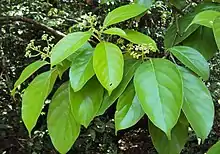Mastixia
Mastixia is a genus of about 19 species of resinous evergreen trees, usually placed in the family Cornaceae. Its range extends from India through Southeast Asia and New Guinea to the Solomon Islands.[2] Mastixia species have alternate or opposite simple broad leaves, many-flowered inflorescences, and blue to purple drupaceous fruits.
| Mastixia Temporal range: | |
|---|---|
 | |
| Mastixia arborea | |
| Scientific classification | |
| Kingdom: | Plantae |
| Clade: | Tracheophytes |
| Clade: | Angiosperms |
| Clade: | Eudicots |
| Clade: | Asterids |
| Order: | Cornales |
| Family: | Nyssaceae |
| Genus: | Mastixia Blume[1] |
| Synonyms[1] | |
| |
The classification of Mastixia is inconsistent due to continuing investigation into its phylogenetic relationships. Although generally placed in Cornaceae, it has also been associated with the family Nyssaceae, when that family is removed from Cornaceae.[3] Mastixia is also sometimes separated, along with the genus Diplopanax, into the family Mastixiaceae.[3]
Species
As of July 2014 the World Checklist of Selected Plant Families and The Plant List recognise about 30 accepted taxa (of species and infraspecific names).[5][6]
- Mastixia arborea (Wight) C.B.Clarke
- subsp. macrophylla (Thwaites) K.M.Matthew
- subsp. meziana (Wangerin) K.M.Matthew ex Ramamoorthy
- Mastixia caudatilimba C.Y.Wu ex Soong
- Mastixia congylos Kosterm.
- Mastixia cuspidata Blume
- Mastixia eugenioides K.M.Matthew
- Mastixia euonymoides Prain
- Mastixia glauca K.M.Matthew
- Mastixia kaniensis Melch.
- subsp. ledermannii (Melch.) K.M.Matthew
- Mastixia macrocarpa K.M.Matthew
- Mastixia macrophylla (Thwaites) Kosterm.
- Mastixia microcarpa Y.C.Liu & H.Peng
- Mastixia montana Kosterm.
- Mastixia nimalii Kosterm. (M. nimali in IUCN[7])
- Mastixia octandra K.M.Matthew
- Mastixia parviflora H.Zhu
- Mastixia pentandra Blume
- subsp. cambodiana (Pierre) K.M.Matthew
- subsp. chinensis (Merr.) K.M.Matthew
- subsp. philippinensis (Wangerin) K.M.Matthew
- subsp. scortechinii (King) K.M.Matthew
- Mastixia rostrata Blume
- subsp. caudatifolia (Merr.) K.M.Matthew
- Mastixia tetrandra (Wight ex Thwaites) C.B.Clarke
- Mastixia tetrapetala Merr.
- Mastixia trichophylla W.P.Fang ex Soong
- Mastixia trichotoma Blume
- var. clarkeana (King) Danser
- var. korthalsiana (Wangerin) Danser
- var. maingayi (C.B.Clarke) Danser
- var. rhynchocarpa Danser
References
- "Mastixia". World Checklist of Selected Plant Families. Royal Botanic Gardens, Kew. Retrieved 31 July 2014.
- Kubitzki, K. (2004). "Cornaceae". In Kubitzki (ed.). The Families and Genera of Vascular Plant. Vol. 6: Flowering Plants: Dicotyledons: Celastrales, Oxidales, Rosales, Cornales, Ericales. New York: Springer-Verlag.
- Fan Chuanzhu; Xiang Qiu-yun (2003). "Phylogenetic analyses of Cornales based on 26S rRNA and combined 26S rDNA-matK-rbcL sequence data". American Journal of Botany. 90 (9): 1357–1372. doi:10.3732/ajb.90.9.1357. PMID 21659236.
- Stevens, Peter F. "Nyssaceae". APWeb. Retrieved 2013-12-01.
- "Mastixia". The Plant List. Retrieved 31 July 2014.
- "Mastixia plant name records". The Plant List. Retrieved 31 July 2014.
- "Mastixia nimali". IUCN Red List of Threatened Species. 1998: e.T33509A9788268. 1998. doi:10.2305/IUCN.UK.1998.RLTS.T33509A9788268.en.